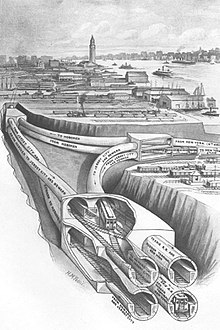 Junction in Jersey City at tubes' west end from a 1909 illustration | |
| Overview | |
|---|---|
| Location | Hudson River and Midtown Manhattan |
| Coordinates | 40°43′48″N 74°01′14″W / 40.7301°N 74.0205°W |
| System | PATH |
| Start | Christopher Street (underwater section) 33rd Street (full line) |
| End | between Hoboken Terminal and Newport |
| Operation | |
| Constructed | 1874–1906 |
| Opened | February 26, 1908 |
| Operator | Port Authority of New York and New Jersey |
| Traffic | Railroad |
| Character | Underground |
| Technical | |
| Design engineer | Charles M. Jacobs |
| Length | 5,650 ft (1,722 m) underwater 3 mi (4.8 km) total |
| No. of tracks | 2 |
| Track gauge | 4 ft 8+1⁄2 in (1,435 mm) standard gauge |
| Electrified | Third rail, 600 V DC |
| Tunnel clearance | 15.25 ft (4.65 m) diameter (southern tube) 18 ft (5.5 m) diameter (northern tube) |
| Depth of tunnel below water level | 97 ft (29.57 m) below river level |
The Uptown Hudson Tubes are a pair of tunnels that carry PATH trains between Manhattan, New York City, to the east and Jersey City, New Jersey, to the west. The tubes originate at a junction of two PATH lines on the New Jersey shore and cross eastward under the Hudson River. On the Manhattan side, the tubes run mostly underneath Christopher Street and Sixth Avenue, making four intermediate stops before terminating at 33rd Street station. The tubes do not enter Uptown Manhattan; the name reflects their location north of the Downtown Hudson Tubes that connect Jersey City and the World Trade Center.
Dewitt Clinton Haskin first attempted to construct the Uptown Hudson Tubes in 1873. Work was delayed by five years by a lawsuit, and was further disrupted by an 1880 accident that killed twenty workers. The project was canceled in 1883 due to a lack of money. A British company attempted to complete the tunnels in 1888, but also ran out of money by 1892, by which point the tunnels were nearly half-finished. In 1901, a company formed by William Gibbs McAdoo resumed work on the tubes, and by 1907, the tunnels were fully bored. The Uptown Hudson Tubes opened to passenger service in 1908 as part of the Hudson & Manhattan Railroad (H&M) and were completed by 1910.
After the Uptown Hudson Tubes' opening, the H&M proposed extending them northward to Grand Central Terminal, as well as creating a crosstown spur line that would run under Ninth Street in Manhattan. However, neither extension was ultimately constructed. In the 1930s, parts of the tubes under Sixth Avenue were rebuilt due to the construction of the Independent Subway System (IND)'s Sixth Avenue Line. The Uptown Hudson Tubes contained seven original stations; two stations at 19th and 28th streets were later closed and the 33rd Street terminal was rebuilt. The Port Authority of New York and New Jersey took over the H&M and the tunnels in 1962, rebranding the H&M as part of the PATH system. The Hoboken–33rd Street and Journal Square–33rd Street services operate through the tubes on weekdays, while the Journal Square–33rd Street (via Hoboken) service operates on weekends, nights, and holidays.
© MMXXIII Rich X Search. We shall prevail. All rights reserved. Rich X Search

